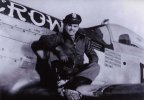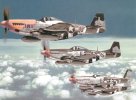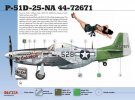The rivet argument has been going on for years, I am sure no 2 planes were alike. General concensus is the rivets are there on the full sized Mustangs, but are flush with the outer skin, the fasteners whick look like large flat head sloted screws are more visible. The wings were pre finished at the factory to have as many seams, gaps and rivets puttied over, then painted silver to aid in the airflow over the wing while the fuselage was nornally untouched. Some ground crews would wax and polish the aircraft to help with the airflow and overall top speed. We cant really look at a restored aircraft to be a definitive reference as many times, the aircraft are stripped to the bare metal or fabric and repainted, sometimes not even using the correct colors. Rarely are panel lines and rivets refilled during a restoration. On a 1/32 Warbird, there should be some detail but Dragon has over done it, and looking at the Tamiya kit, it looks like they were a little heavy handed too. Hopefully the pictures I have seen are of test shots and not sprues from the actual production run.
Here is one of Bud Anderson's Mustangs, quite visible are the fasteners used to hold the engine access panels in place. Barely visible are a few rows of rivets.

Here is Bud sitting in a restorede P-51D, again, rivets are there but barely visibnle on the fuselage.
and just posting this coz its one of my fovorite period Mustang pictures... And it isnt colorized, it was originally photgraphed with color film. Note the 2 lead aircraft are featured as markings options with the standard Tamiya 1/48 8th AF P-51D Mustang kit.

And here is an example of a really bad restoation of the second Mustang in the above picture, they somehow thought (probably based on a b/w photo) that they should use a glossy medium blue instead of a mat olive drab???, there are many other examples liek this, niot just of mustangs, but other a/c as well.
















